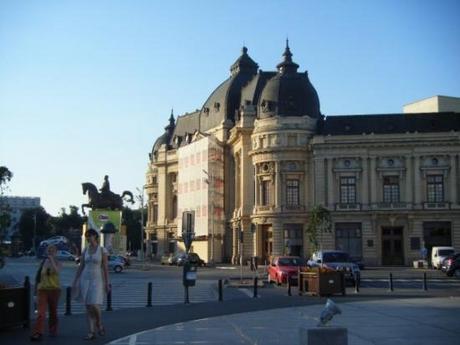The University of Bucharest
The foundations of the present building of the University placed in University Square were laid in 1857. For this very important event a medal was stamped. It can be admired today in the Numismatic Collection of the Romanian Academy.
The building was erected after a competition during which more offers have been analysed. The winner of this competition brought together 70 Austrian builders. The stone and the marble were brought from Pest (a part of the present Hungarian capital, Budapest) on the Danube to Giurgiu and afterwards in carts to Bucharest, as the railway linking Bucharest to Giurgiu - port to the Danube - was constructed only in 1869. Because of the lack of financial resources, the building was inaugurated after twelve years, in 1869. The original building had two floors and was constituted only of the part that lines nowadays Carol Boulevard. The façade had a peristyle with ionic columns and bas-reliefs made by Karl Storck. Unfortunately, during the aerial allied bombardments in 1944, the works of Karl Storck were destroyed. Initially, the edifice also housed other institutions, as the Senate, the Romanian Academy, the Central Library, the Antiquities and Natural History Museum, the Art School a.o. The other wings were constructed under the direction of Nicolae Ghica-Budesti between 1912 and 1926.
From the 17th century to the first decades of the 19th, on the very spot on which University Square is to be found today, were the buildings and the garden of the Saint Sava Monastery. It was there that functioned the 'High Society School', which became in 1709 the 'Princely Academy', initiated by Constantin Brancoveanu, a centre of culture famous in south-eastern of Europe.
At the beginning of the 19th century, after 1817, St. Sava Monastery housed St. Sava College, the first superior school with Romanian teaching. French was the teaching language for a short time in 1847, but the 1848 Revolution reintroduced Romanian. As there was not a clear-cut distinction between secondary and superior school, this college represented both levels.
The University was founded as a superior school in 1864, four years after the Iasi University, the first Romanian modern university. In 1864 it included the Law, Sciences, Letters and Philosophy Faculties. The first doctor's degree was given in 1873 by the Pharmacy Faculty.
The University's 'golden age' was between the two world wars. It ranked then, thanks to the quality of the teachers and the number of students (15700 students), among the greatest universities, along with Columbia University in New York, Paris University, London University and New York University.
In 1945 this remarkable period finished brutally, as some of the best professors were destituted, while some others were emprisoned for having opposed, in one way or another, the emerging communist régime. After several years, some of them could come back, but the atmosphere was no longer the same, that of liberty of thinking and open competition. After 1990, segnificant progress had been recorded in the quality of teaching, with an increased number of students. It has nowadays approximately 20,000 students and 14 faculties.




